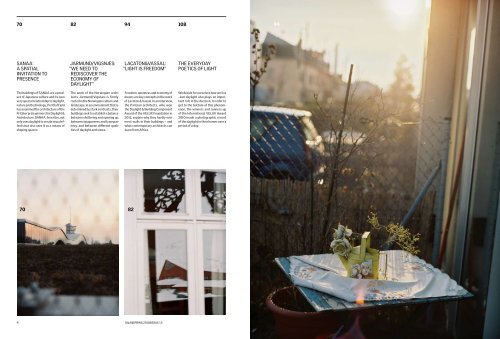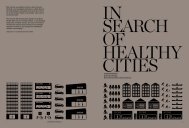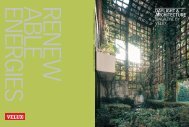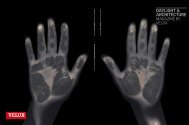Download as PDF - Daylight & Architecture - Magazine by | VELUX
Download as PDF - Daylight & Architecture - Magazine by | VELUX
Download as PDF - Daylight & Architecture - Magazine by | VELUX
You also want an ePaper? Increase the reach of your titles
YUMPU automatically turns print PDFs into web optimized ePapers that Google loves.
SPRING 20116 14 244254 56ISSUE 15ContentsBody Clocks, Light,Sleep and HealthThe experienceof daylightImagining light: theme<strong>as</strong>ureable andthe unme<strong>as</strong>urableof daylight designIn search of ananthropologyof daylight4×ARCHITECTURE &DAYLIGHTWILL BRUDER:“Light definesthe journey ofour lives”<strong>VELUX</strong> Editorial 2Contents 4Body Clocks, Light, Sleep and Health 6The experience of daylight 14Imagining Light: The me<strong>as</strong>ureable and the 24unme<strong>as</strong>urable of daylight designIn search of an anthropology of daylight 424×<strong>Architecture</strong> & <strong>Daylight</strong> 54Will Bruder: “Light defines the journey of my life” 56Sanaa: A spatial invitation to presence 70Jarmund Wigsnaes: “We need to rediscover the economy of daylight” 82Lacaton/V<strong>as</strong>sal: ”Light is freedom” 94IVA, International Velux Award 104The everyday poetics of life 106“We live our lives in dim caves,” saysthe neurophysiologist Russell Foster.Electric light and the emergenceof the ‘round-the-clock’ society haveincre<strong>as</strong>ingly isolated us from therhythms of nature. In his article for<strong>Daylight</strong> & <strong>Architecture</strong>, Foster describesthe consequences this is havingfor human beings.Why do people prefer daylight toartificial light, even though bothprovide enough light to see <strong>by</strong>? Environmentalpsychologist JudithHeerwagen investigated this matterclosely and, referring to current research,came to the conclusion thatthis preference is due to human evolution.“A room is not a room without naturallight,” says the American architectLouis Kahn. In his article,Dean Hawkes examines how Kahnand other pioneering architectshave worked with daylight in theirbuildings. Great architecture, accordingto Hawkes, is b<strong>as</strong>ed on theoptimal relationship of quantitativeand qualitative <strong>as</strong>pects in the use ofdaylight.Many architects value the functionaland aesthetic advantagesof daylight but only know very littleabout its psychological effect. Inhis article, Brent Richards looks athow these are<strong>as</strong> of knowledge canbe more closely interlinked. His conclusion:two things are necessary –the holistically thinking architect,and interdisciplinary planning teamsin which specialists in different subjectsinspire each other.Every building h<strong>as</strong> to mediate anewbetween a specific site with its climateand daylight, and universalhuman needs. How this can be donesuccessfully is shown in <strong>Daylight</strong> &<strong>Architecture</strong> <strong>by</strong> four architects’ officesfrom all over the world: WillBruder from Phoenix, SANAA fromTokyo, Jarmund/Vigsnæs from Osloand Lacaton & V<strong>as</strong>sal from Paris.The American architect Will Bruderh<strong>as</strong> been living in Phoenix, Arizona,for more than 40 years. The city,the surrounding desert landscapeand its light have exerted a l<strong>as</strong>tinginfluence on his work. In an interviewwith <strong>Daylight</strong> & <strong>Architecture</strong>,Bruder describes how he makes useof light to ennoble even the mostsimple structures and materials inhis buildings.6 14 24 502 D&A SPRING 2011 Issue 15 3










